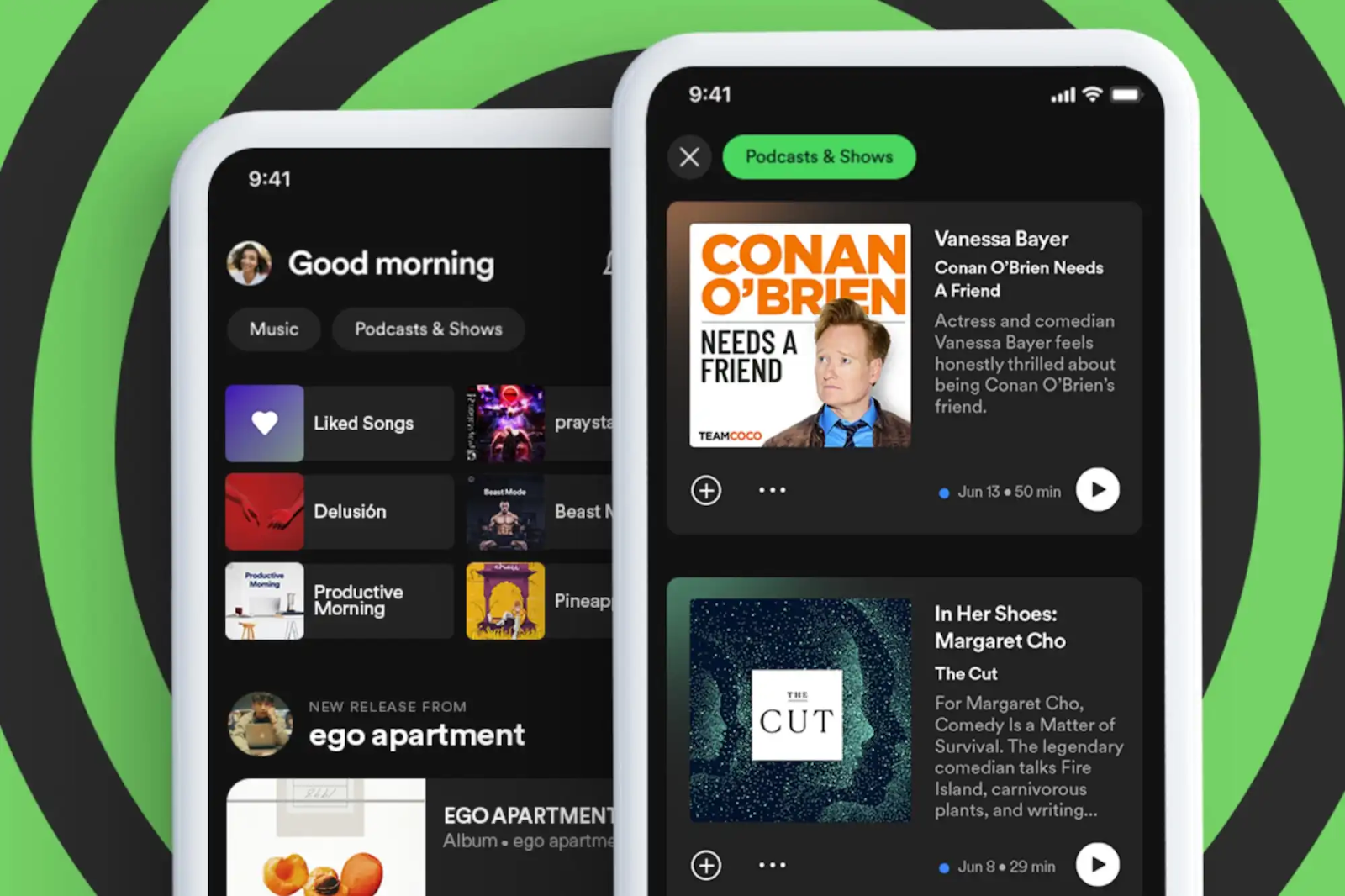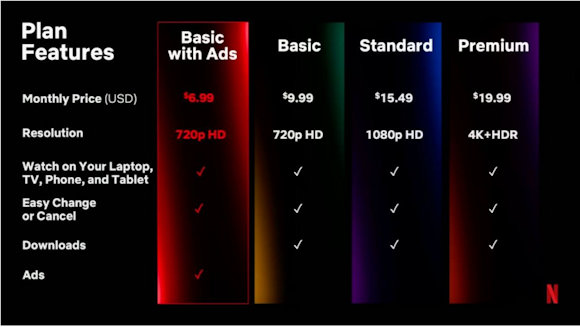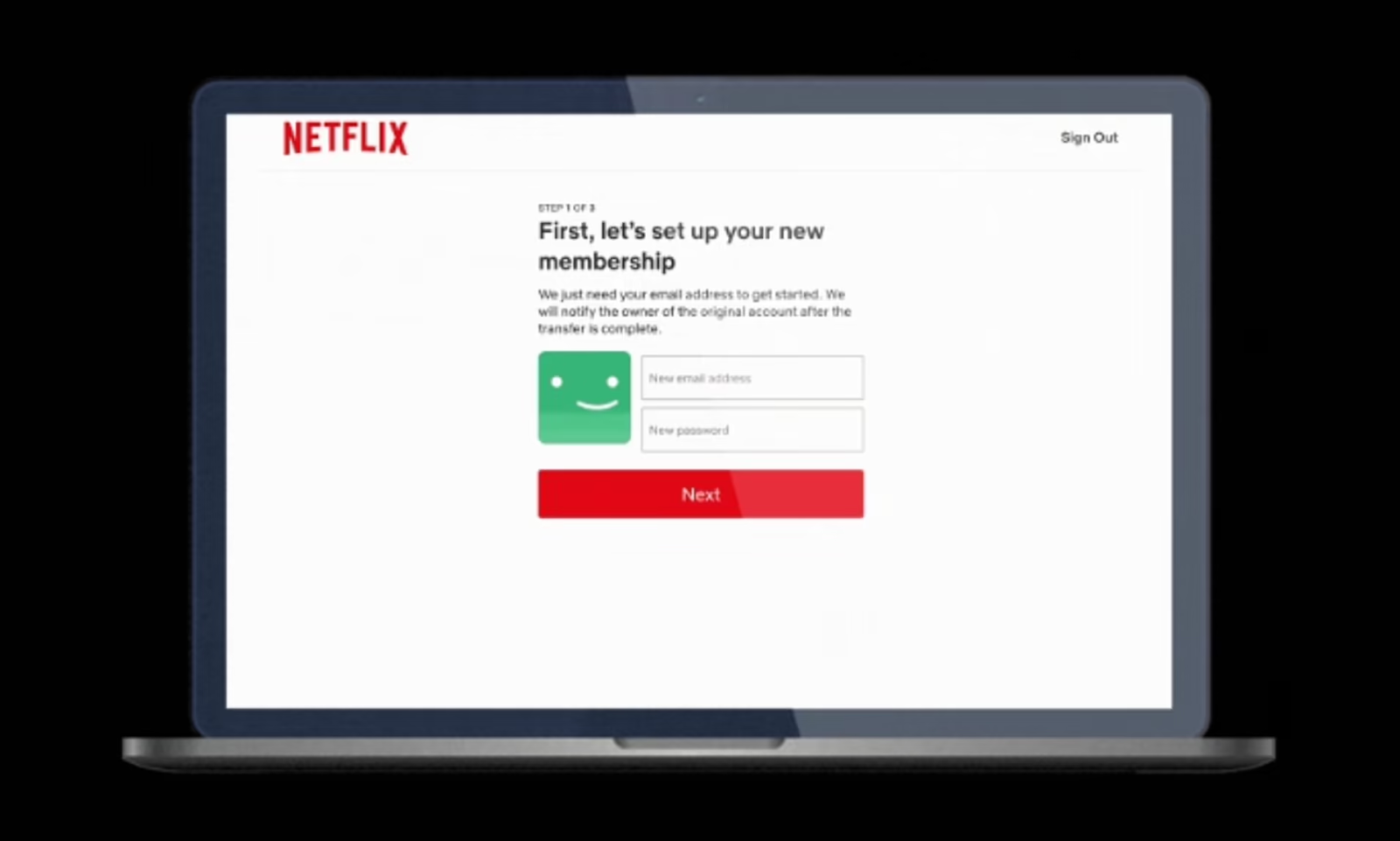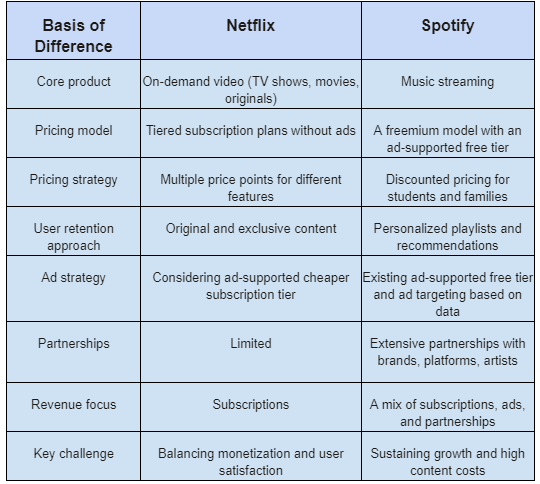How Netflix and Spotify are Changing Their Monetization Strategies
Spotify was founded in 2008 and has since grown to become the world’s leading Music Streaming App, generating over $11.2 billion in 2022.

Netflix, on the other hand, remains the top OTT video streaming app, despite growing competition, generating over $31.6 billion in 2022 revenue. Like Spotify dominates music streaming, Netflix leads in video with over 238 million subscribers worldwide.
However, both applications have different markets and target audiences, but a fundamental similarity between these streaming giants is relentless innovation across all aspects of their business, from marketing to
monetization. Whether it’s Spotify’s expansion into podcasts or Netflix’s shifts to owned original content, both platforms creatively evolve their offerings and strategies. These mobile streaming apps always think outside the box, finding new ways to attract and retain subscribers to stay ahead. This constant innovation to “go beyond” has fuelled their leadership in streaming entertainment.
If you’re also thinking of building a Music Streaming App or OTT platform, then this guide is for you. We, the leading Music App Development Company In California, will explore how Netflix and Spotify are changing their monetization strategies to meet the demands of today’s audiences that can help you develop a reliable app monetization strategy to drive a higher ROI.
So, let’s get started.
Before exploring how industry giants like Spotify and Netflix have evolved their monetization strategies, look at how you can monetize your On-Demand Music Streaming App.
How Netflix and Spotify are Changing Their Monetization Strategies
Spotify and Netflix, have become the giant in the streaming world by disrupting traditional business models for music and video entertainment. Initially, both companies relied on simple subscription plans as their primary revenue driver. However, as the streaming wars heat up against deep-pocketed rivals, Spotify and Netflix have had to get creative with monetization strategies beyond just subscriptions. Let’s look at their monetization strategies.
Spotify Innovative Monetization Strategies
Spotify rapidly became a top global Music Streaming App through its convenient, on-demand access to millions of songs. However, its freemium model meant revenue from premium subscriptions alone could not sustain long-term profitability. Spotify realized it needed to diversify monetization early on. Here is a summary of how Spotify’s creative revenue-generating methods evolved.
1. Premium Subscriptions Established Early Revenue (2008)
When Spotify first launched, one of its key monetization strategies was offering premium subscriptions. Now it’s pioneered Music Streaming Mobile App Development subscriptions, offering ad-free listening and advanced features for $9.99 monthly. This set the foundation for their business model.
Moreover, Spotify introduced the family plan in 2014, but much has changed. An entire household may now enjoy Spotify Premium for less than the cost of two Premium memberships. At present, Spotify is still exploring its premium strategy and upgrading its offerings for users to provide a seamless experience.
This premium model accounted for over 90% of Spotify’s $11.2 billion in 2021 revenues. Price hikes and discounted family plans aim to improve ARPU. Converting more of Spotify’s 515 million total users into paying subscribers is a key profit driver.

2. Harnessing Data to Hook Listeners Through Personalization (2009- Present)
As Spotify grew, it leveraged data and analytics to provide users with personalized recommendations and curated playlists.
Now Spotify has over 515 million users generating over 5 billion streams daily.
This data-driven personalization hooked users, increased time spent on the platform, and enhanced discovery features like algorithmic playlists leading to higher conversion rates and lower churn. The more tailored Spotify’s experience via data, the more addictive its platform becomes for its users.
3. Targeted and Programmatic Ads
Beyond subscriptions, Spotify monetized its ad-supported user base through highly targeted audio/video ads in 2014. Spotify aims to match the right promotions to each user based on their listening habits and demographics.
Spotify’s streaming ad insertion (SAI) tech also enables precise programmatic ad delivery. As personalization improves, Spotify can charge brands higher premiums. This provides significant revenue from free users.
4. Diversifying into High-Margin Podcast Content (2015 – Present)

Spotify has wisely diversified beyond the Music Streaming Application development industry by investing over $1 billion in podcast content in 2015. Acquiring networks like Gimlet, Anchor, and Parcast gave Spotify a library of over 3.2 million podcasts. Podcasts can be monetized through ads at high margins without any royalty fees.
JP Morgan estimates Spotify’s podcast margins exceed 70%. Podcast ads delivered $200 million in 2021 revenue, doubling over 2020.
With exclusives like The Joe Rogan Experience, Spotify is quickly capturing podcast market share from Apple. Podcasts also increase user engagement and retention while attracting new demographics. Podcast content represents a lucrative second revenue engine for Spotify beyond just premium music subscriptions.
5. Strategic Partnerships Expand Reach and Users
In 2016, Spotify did key partnerships with Facebook, Samsung, and Google, which helped Spotify to pre-install apps and drive sign-ups through bundle deals. These partnerships are crucial for entering and dominating new global markets.
Spotify’s valuable first-party data also allows artists and brands to target promotions via sponsored playlists and other engagement opportunities finely.
Netflix’s Evolving Monetization Strategy
Netflix pioneered the subscription video-on-demand(VOD) model when it transitioned from DVD rentals to streaming in 2007. This recurring subscription revenue has been the core of its business. However, it slowly adopted new technology and strategies to position itself well in this dominant Video Streaming App landscape. Let’s have a look at them.
1. Tapping into Mobile Gaming Revenue 2021
Netflix’s move into video games represents a bold diversification beyond video content. Mobile games offer Netflix a new revenue stream while increasing subscriber engagement. However, Netflix faces stiff competition from gaming giants like Apple, Google, and Electronic Arts.
To stand out, Netflix aims to leverage hit shows like Stranger Things into engaging, high-quality games integrated with the broader viewing experience. If Netflix can convert even a small portion of subscribers into gamers, it could translate into meaningful revenue. The key will offer exclusive games tied to Netflix IP rather than generic add-ons.
2. Diversifying Revenue Streams with Ad-Tier in 2022
After years of resisting ads, Netflix launched a lower-priced ad-supported plan in November 2022. The cheaper ad tier targets more price-sensitive users, increasing advertiser revenue from Netflix’s addressable audience of over 220 million households.
To support this new tier, Netflix acquired ad tech firm MediaHive and partnered with Microsoft for sales and delivery. With viewership data rivaling social media, Netflix aims to reinvent TV advertising. And this is how it becomes the most favorable Video Streaming App for users.

3. Clamping Down on Password Sharing

Netflix has allowed password sharing among family members in the same household since its streaming service launched in 2007.
The ability to share one account with multiple profiles made it easy for households to share access. As per an estimate, over 100 million households are “borrowing” Netflix credentials instead of paying. To convert this usage into revenue, Netflix tests payment features for account sharing.
Strategically, some subscriber loss is acceptable if offset by payments from non-subscribing viewers. The challenge will be finding the right balance of pricing and rules to minimize churn. For now, Netflix is taking a cautious approach by rolling this out in limited markets.
4. Owning Bigger Pieces of IP (Ongoing)
As licensed content costs are soaring, Netflix wants to own a larger share of its hit shows and movies. Original TV Series like Stranger Things, The Witcher, Ozark, and films like The Irishman, The Old Guard, etc., have major merchandising potential once Netflix controls the IP.
This mirrors Disney’s success capitalizing on owned franchises. While risky, Netflix is betting big budgets on owned IPs like The Gray Man universe. The potential of long-term franchises and licensing revenue makes the upfront investment worthwhile.
For those interested in diving deeper into the intricacies of video streaming apps, our Video Streaming Apps-Attributes and Development Costs guide is a valuable resource.

Want to build an app like Netflix? Check out this guide.
Analysis & Comparison of Strategies
Netflix and Spotify have some notable similarities and differences in how they change their monetization strategies as subscription streaming giants.
Both are focused on growing their global user bases and retaining loyalty. However, their approaches reflect the differences in their markets. Netflix leverages investments in original movies, TV shows, and documentaries to give subscribers exclusive, entertaining content they can’t get elsewhere. This builds value for the subscription.
On the other hand, Spotify doesn’t create music but competes through curation and personalization. By recommending music catered to individual tastes, Spotify creates a continually engaging experience that locks in listeners.
Interestingly, both companies are exploring supplemental advertising revenues but in different capacities. Netflix is considering an ad-supported subscription tier at a lower price point. Spotify already offers a free, ad-supported tier as well as a Premium no-ads tier. Netflix would introduce ads to customers accustomed to an ad-free experience, while Spotify’s users can select their preferences.
Challenges for both lie in balancing revenue growth with user satisfaction. Measures like password-sharing crackdowns, subscription price hikes, and inserting more ads may drive revenue but risk alienating subsets of the user base.
Netflix and Spotify must invent monetization in a way that aligns with subscribers’ perceptions of value.
The Music Streaming Application development landscape is growing more competitive, so retaining loyal users through compelling and reasonably priced services will be the key.
Strategic Differences: Netflix Vs. Spotify
While Netflix and Spotify both aim to diversify revenue streams, their strategies leverage different advantages that reflect the nature of their content and markets. This table outlines critical contrasts in the two streaming giants’ emerging monetization approaches.

Conclusion:
Netflix, and Spotify exemplify rapid innovation in streaming monetization, evolving their models beyond just subscriptions. Netflix has added an ad tier, clamped down on password sharing, and invested heavily in owned IP, aiming to extract more revenue from its base.
Similarly, Spotify has complemented subscriptions with a booming podcast business. Both leverage personalization and partnerships to optimize engagement and penetration.
But have you ever wondered what’s the secret behind it? They constantly innovate to create new revenue streams that coax more value from existing ones. This constant experimentation and evolution are precisely what any budding streaming firm must emulate.
Rather than copying established models, stand out by envisioning creative new monetization frontiers. As you consider venturing into music streaming app development, remember that it’s not just about technical prowess; a blend of innovation and creativity is paramount. At Consagous, we embody this synergy.
We are a premium music-streaming mobile app development company that can transform your business with cutting-edge mobile streaming solutions.
Our data-driven approach finds the optimal balance between monetization and satisfaction. With strategic subscriptions, targeted advertising, and incremental models, generate revenue while keeping users engaged.
Further, our Music Streaming App developers team is just as creative as technically proficient. Whether employing sophisticated algorithms to personalize content or leveraging data-driven insights to engage users, they think outside the box. Their creative problem-solving delivers innovative features that satisfy and delight users.
Don’t miss the mobile streaming app revolution—unlock your app’s potential with Consagous Technologies. Contact us now to achieve unprecedented success and revolutionize your digital entertainment presence. Seize the opportunity today!

